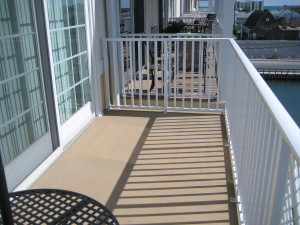Railing Connections

Guards are generally vital elements that perform a life safety role. We see them along balconies, retaining walls, walkways, stairs, and terraces. Often these items are mistakenly called guardrails, but the Code calls them guards because the entire assembly and not just the top rail is what is intended to prevent a fall. Guards are different from a handrail according to the Building Code (see an upcoming post for a discussion of handrails). Guards are required when a fall from one surface to a lower surface of more than 30-inches is possible.
Therefore, it is important to inspect your guards periodically to ensure that a fatal accident is not looming at your building. We often find that guards are loose when shaken, due to missing or severely corroded fasteners, loose material surrounding the posts cast in the concrete, posts that are corroded through, or broken welds. The Building Code has requirements for the load capacity of guards and if these defects exist, your guard could be non-compliant with the Code.
In addition, pickets or the material that serves to fill the space between the posts must be able to resist a certain amount of load according to the Code, so if you have loose pickets or degraded wood panels the guards are likely out-of-Code. Often wooden guard systems are problematic as they have pickets with nails that work loose over time. Missing pickets are also a Code violation and a hazard.
Currently the Building Code requires that all guards be a minimum of 42-inches above the walking surface and have spaces that will not allow a 4” ball to pass through. The rails must be able to resist either a 200-pound point load or a 50-pound per linear foot load, whichever is worse. Railing infill materials must be able to resist a 50 pound when placed on a one square foot area.

